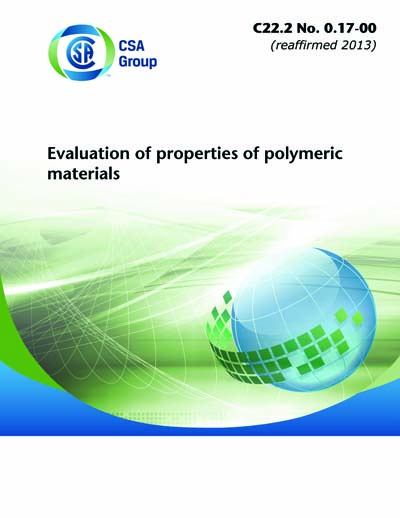Historical
CAN/CSA C22.2 NO. 0.17-2000 (R2013)
CAN/CSA-C22.2 NO. 0.17-00 (R2009) - Evaluation of Properties of Polymeric Materials
Update #2 was published as notification that this is now a National Standard of Canada.
Update(s) to this standard are available. To download any updates and/or register for email notification of future updates click here.
Intended Use
This is a zero series standard and as such may be referenced by all other part 2 standards.
Scope
1.1 This Standard provides procedures for evaluating polymeric materials and parts made from polymeric materials intended for application in electrical equipment covered by the Canadian Electrical Code, Part II (CEC, Part II), with respect to: (a) flammability; (b) mechanical properties; (c) thermal properties; (d) resistance to weathering; and (e) electrical properties.1.2 The test procedures listed in this Standard are provided for reference in the Standards forming Part II of the Canadian Electrical Code. Although the verbal auxiliary shall is used to state the requirements of each test procedure given, it is essential to recognize that the procedures are nonmandatory in themselves unless mandated by individual Standards. Note: Most of these procedures are recognized internationally for evaluating polymeric materials and are equally applicable to areas other than electrical.
1.3 This Standard provides procedures for making reproducible observations and serves as an aid in classifying materials according to the criteria set forth in the individual Standards.
1.4 The procedures described in this Standard involve standard-size specimens tested under laboratory conditions and are intended to be used solely to measure and describe the properties of material. They are intended to serve as a preliminary indication of the material's acceptability for a particular application. The performance level of a material by these methods may vary in the end-use application.
1.5 Test procedures for classifying electrical wires and cables are not specified in this Standard.
Notes: (1) This Standard may involve hazardous materials, operations, and equipment. This Standard does not purport to address all of the safety problems associated with its use. It is the responsibility of the user of this Standard to establish appropriate safety and health practices and determine the applicability of regulatory limitations prior to use. (2) This Standard should be used to measure and describe the properties of materials, products, or assemblies in response to heat and flame under controlled laboratory conditions and should not be used to describe or appraise the fire hazard or fire risk of materials, products, or assemblies under actual fire conditions. However, results of each test may be used as an element of a fire risk assessment that takes into account all of the pertinent factors of a particular end use. (3) The test methods described in this Standard are not intended to assess fire hazard. The fire hazard created by materials depends upon the form and end use of the material. Assessment of fire hazard includes, but is not limited to, many factors, such as ease of ignition, burning rate, flame spread, fuel contribution, intensity of burning, and products of combustion.
Content Provider
CSA America, Inc. [csa]






